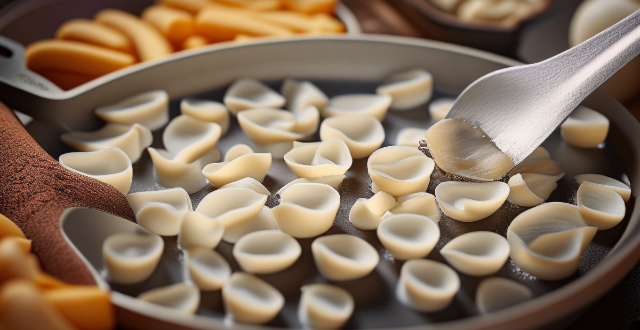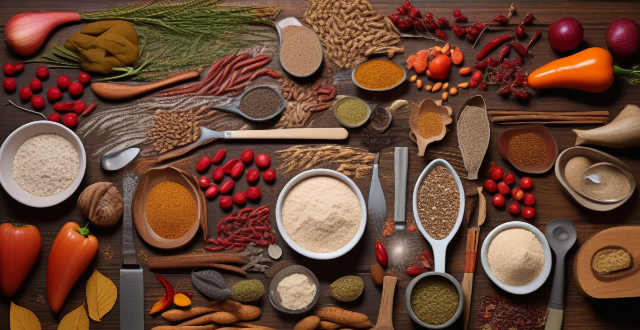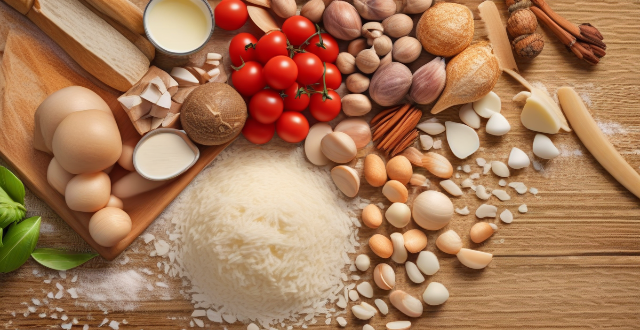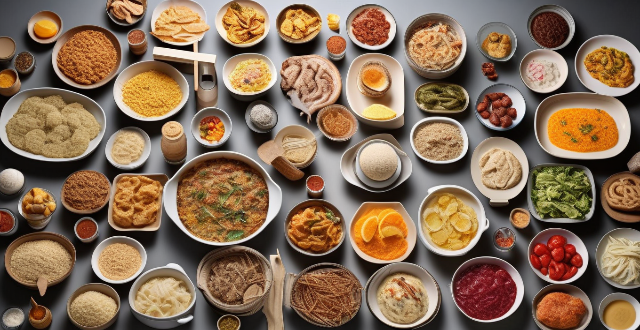Indian Rice

What are the key ingredients in Indian cooking ?
Indian cuisine is known for its rich flavors and diverse dishes. The key ingredients that make Indian cooking unique are spices, herbs, ghee, lentils, rice, yogurt, nuts and seeds, and bread. These ingredients add flavor, color, and aroma to the dishes and create authentic and delicious Indian cuisine.

Can vegetarians enjoy a variety of Indian food ?
Vegetarians can enjoy a variety of Indian food due to the country's diverse cuisine and common dietary choice. Traditional vegetarian dishes like Chana Masala and Palak Paneer offer delicious options, while regional variations such as South Indian Dosas and Gujarati Thali provide unique flavors. Street food also presents numerous vegetarian choices like Pani Puri and Vada Pav. Additionally, global influence has led to more vegetarian versions of classic dishes in restaurants worldwide.

How has Indian cuisine evolved over time ?
The evolution of Indian cuisine is a result of various factors such as geography, climate, history, culture, and trade. India's diverse geography and climate have led to unique culinary traditions in each region, with coastal areas known for seafood dishes and northern plains famous for dairy products and bread. Historical influences like the Mughal era and British colonial period have also shaped Indian cuisine, introducing fusion dishes and bakeries. Trade routes and globalization have integrated foreign flavors into Indian dishes, while regional variations highlight the country's culinary diversity. Modern innovations include fusion dishes and healthier versions of traditional recipes. Overall, Indian cuisine reflects the nation's rich cultural diversity and adaptability to changing trends.

How do I make a traditional Indian curry at home ?
How to Make a Traditional Indian Curry at Home Indian curry is a flavorful and aromatic dish that can be made with various vegetables, meats, or legumes. Here's a step-by-step guide to making a traditional Indian curry at home: Ingredients: - 2 tablespoons vegetable oil - 1 onion, finely chopped - 2 garlic cloves, minced - 1 tablespoon grated fresh ginger - 2 teaspoons ground cumin - 1 teaspoon ground coriander - 1 teaspoon turmeric powder - 1 teaspoon paprika - 1 teaspoon salt - 1 can (14 ounces) diced tomatoes - 1 can (14 ounces) coconut milk - 1 pound chicken breasts or thighs, cut into bite-sized pieces - Fresh cilantro leaves, chopped (optional) Instructions: Step 1: Heat the Oil Heat the vegetable oil in a large skillet over medium heat. Step 2: Sauté the Onion Add the chopped onion to the skillet and cook until it becomes translucent, stirring occasionally. This should take about 5 minutes. Step 3: Add Garlic and Ginger Stir in the minced garlic and grated ginger and cook for another minute until fragrant. Step 4: Add Spices Add the ground cumin, ground coriander, turmeric powder, paprika, and salt to the skillet. Stir well to combine with the onion mixture. Cook for about 30 seconds until the spices are fragrant. Step 5: Add Tomatoes and Coconut Milk Pour in the can of diced tomatoes and coconut milk into the skillet. Stir well to combine all the ingredients. Bring the mixture to a simmer. Step 6: Add Chicken Add the bite-sized pieces of chicken to the skillet. Stir well to coat the chicken with the sauce. Cover the skillet with a lid and let it simmer for about 20 minutes or until the chicken is cooked through. Step 7: Garnish with Cilantro (Optional) Once the chicken is cooked, remove the skillet from heat and sprinkle some fresh cilantro leaves on top of the curry if desired. Your traditional Indian curry is now ready to serve! Enjoy it with rice or naan bread for a complete meal.

Can you recommend a good Indian restaurant in my city ?
This text provides recommendations for Indian restaurants in the city and offers tips for choosing one. The author suggests five different restaurants, each with its own unique offerings such as authentic North Indian cuisine, spicy South Indian delicacies, street food snacks, fine dining options, and family-friendly menus. The author also advises readers to consider factors like authenticity, variety, atmosphere, and service when selecting an Indian restaurant.

What are some common misconceptions about Indian food ?
Indian cuisine is known for its rich flavors, spices, and diverse range of dishes, but there are several misconceptions about Indian food that people often believe. Here are some of the most common misconceptions: 1. All Indian food is spicy: Many Indian dishes do use a variety of spices, but not all of them are spicy. There are plenty of mild and sweet dishes in Indian cuisine as well. 2. Indian food is only vegetarian: While vegetarianism is prevalent in India, there are plenty of non-vegetarian dishes as well, such as Butter Chicken, Chicken Tikka Masala, and Lamb Curry. 3. Indian food is always greasy: Some dishes may be fried or cooked with ghee (clarified butter), but there are plenty of healthy options available as well. Many Indian households prepare dishes using fresh vegetables, lentils, and whole grains, which are both nutritious and delicious. 4. Indian food is expensive: Some people assume that Indian food is expensive because it uses exotic spices and ingredients. However, many Indian dishes can be made with affordable ingredients that are easily available in local markets. 5. Indian food takes a long time to cook: While some dishes may require longer cooking times, many others can be prepared quickly and easily. Dishes like Chana Masala, Palak Paneer, and Aloo Gobi can be cooked within 30 minutes or less. By understanding these myths and exploring the diversity of Indian cuisine, one can appreciate the richness and complexity of this unique culinary tradition.

What are some popular Indian dishes ?
Popular Indian dishes include Biryani, Chole Bhature, Dal Makhani, Dosa, Samosa, Tandoori Chicken, and Vada Pav. These dishes showcase the rich flavors, diverse ingredients, and vibrant colors of Indian cuisine.

What is the significance of spices in Indian cooking ?
The significance of spices in Indian cooking is multifaceted, encompassing flavor enhancement, cultural traditions, and medicinal benefits. Key spices like turmeric, cumin, coriander, mustard seeds, fenugreek, red chili powder, garam masala, curry leaves, asafoetida, and tamarind contribute to the complex flavor profiles characteristic of Indian cuisine. These spices are used through techniques such as tempering, grinding, and roasting to create a balance of tastes and visual appeal. Historically, spices were valuable commodities in trade and are integral to traditional medicine and religious practices. Regional variations in spice use reflect India's diverse geography and cultural heritage. Understanding the nuances of spice usage allows for a deeper appreciation of the artistry behind Indian dishes.

How do I choose the right type of rice for Chinese cooking ?
When it comes to Chinese cooking, selecting the rightWhen it comes to Chinese cooking, selecting the right for achieving the desired texture and selecting the right type of rice is crucial for achieving the desired texture and flavor in your dishes. Consider the dish you are making, look for quality and freshness when purchasing rice, and don't forget to consider your personal preferences. By following these steps, you can choose the perfect type of rice for your Chinese cooking needs.

Is Indian food spicy ?
The text discusses the spiciness of Indian food, explaining that it varies greatly depending on several factors such as regional variations, personal preferences, specific dish characteristics, ingredients contributing to spiciness, and cultural considerations. It notes that some dishes can be very spicy while others may be mild or even sweet, and suggests asking for a milder version or specifying preferences when ordering if one has a low tolerance for spice.

What are the best travel destinations for foodies ?
The text discusses the best travel destinations for food lovers, including Italy, France, Japan, Thailand, and India. The author provides a brief overview of each country's cuisine, highlighting some popular dishes that are unique to each destination.

How do I make a Japanese-style bento box ?
Bento boxes are a traditional Japanese meal that is packed in a box and typically consists of rice, fish or meat, and vegetables. Here's how you can make your own Japanese-style bento box: Ingredients: - 1 cup of cooked white rice - 1/2 pound of thinly sliced beef or chicken - 1 tablespoon of soy sauce - 1 tablespoon of sugar - 1 tablespoon of mirin (Japanese sweet cooking wine) - 1 teaspoon of sesame oil - 1/4 cup of sliced carrots - 1/4 cup of sliced bell peppers - 1/4 cup of sliced cucumbers - 1/4 cup of sliced cherry tomatoes - 1 sheet of nori (dried seaweed) - Salt and pepper to taste Instructions: 1. Marinate the Meat: In a bowl, mix together the soy sauce, sugar, mirin, and sesame oil. Add the sliced beef or chicken and let it marinate for at least 30 minutes. 2. Cook the Rice: Cook the rice according to package instructions until it is soft and fluffy. Set aside to cool slightly. 3. Prepare the Vegetables: Slice the carrots, bell peppers, cucumbers, and cherry tomatoes into thin strips. Season them with salt and pepper. 4. Cook the Meat: Heat a pan over medium heat and cook the marinated meat until it is browned and cooked through. Set aside to cool. 5. Assemble the Bento Box: Take a bento box and fill one compartment with the cooked rice. Arrange the cooked meat and vegetables in separate compartments or on top of the rice. Cut the nori into small pieces and sprinkle them over the rice and vegetables. 6. Enjoy Your Bento Box: Your Japanese-style bento box is now ready to be enjoyed! Eat it as a delicious and healthy meal or pack it for a picnic or lunch on-the-go.

How do I make a bento box meal ?
How to make a bento box meal with rice, protein, vegetables, and garnishes. Includes steps for cooking rice, preparing protein, cutting vegetables, assembling the bento box, and packing it for later enjoyment.

What kind of ingredients are commonly used in Japanese cuisine ?
Japanese cuisine is known for its unique flavors, fresh ingredients, and beautiful presentation. The most commonly used ingredients in Japanese cooking include white rice, brown rice, sweet rice, tuna, salmon, squid, shellfish, chicken, beef, pork, cabbage, eggplant, green onions, mushrooms, soy sauce, miso, udon noodles, soba noodles, ramen noodles, rice vinegar, sesame oil, nori, wasabi, and pickled ginger. These ingredients combine to create the diverse and delicious flavors that make Japanese cuisine so beloved around the world.

How do I make sushi at home ?
Sushi is a popular Japanese dish that has gained worldwide popularity for its delicious taste and health benefits. Making sushi at home can be a fun and rewarding experience. Here are the steps to follow: Ingredients: - Sushi rice - Nori sheets - Fish fillets (salmon, tuna, or any other fish of your choice) - Vegetables (cucumber, avocado, carrots) - Soy sauce - Wasabi - Pickled ginger Tools: - Bamboo sushi mat - Rice cooker or pot - Sharp knife Steps: 1. Cook the sushi rice by rinsing it in cold water until the water runs clear, then cooking it with water in a pot until all the water has been absorbed. Mix the cooked rice with sushi vinegar using a wooden spoon. 2. Prepare the fish and vegetables by cutting them into thin slices and long, thin strips respectively. 3. Assemble the sushi rolls by placing a sheet of nori on top of the bamboo sushi mat, spreading a small handful of sushi rice evenly over the nori sheet leaving about an inch gap at the top, arranging the fish and vegetable slices on top of the rice, and rolling the sushi tightly using the bamboo mat. Wet the gap at the top of the nori sheet with water to seal the roll. 4. Cut the sushi rolls into bite-sized pieces using a sharp knife, wiping the knife with a damp cloth between each cut to prevent sticking. 5. Serve the sushi by arranging the pieces on a plate and serving with soy sauce, wasabi, and pickled ginger. Enjoy your homemade sushi!

How can I make a delicious and nutritious dinner using only pantry staples ?
In this article, we explore how to make a delicious and nutritious dinner using only pantry staples. Key ingredients include grains like rice and pasta, proteins such as canned beans and nuts, and vegetables like canned tomatoes and dried herbs. We provide steps for creating a balanced meal, including choosing a grain, adding protein, boosting flavor with herbs and spices, incorporating vegetables, and serving the finished dish. An example recipe for a quick and easy rice and beans bowl is also included. Overall, this article offers practical tips and ideas for whipping up a satisfying meal without needing to go grocery shopping.

How can I make my favorite takeout dishes at home ?
Learn how to make your favorite takeout dishes at home with these tips and tricks. Gather all the necessary ingredients, including spices, proteins, vegetables, sauces, and rice or noodles. Equip yourself with sharp knives, mixing bowls, a wok or large pan, a steamer basket, and a rice cooker or pot. Master techniques such as marinating, stir-frying, steaming, and simmering. Don't rush the process; taste as you go; use fresh ingredients; experiment with spices; and practice makes perfect. Making your favorite takeout dishes at home is not only cost-effective but also allows you to customize them to your liking.

How do I make vegetarian versions of classic comfort foods ?
Vegetarian versions of classic comfort foods can be just as satisfying and delicious as their meat-based counterparts. Here are some tips on how to make vegetarian versions of classic comfort foods: 1. Start with a hearty base like lentils, beans, or tofu. 2. Add rich flavors like cheese, cream, or butter. 3. Use spices and herbs for depth and complexity. 4. Get creative with grains like rice, quinoa, or pasta. 5. Incorporate vegetables by roasting, sautéing, or adding raw to salads. 6. Try meat alternatives like plant-based burgers, sausages, and bacon. 7. Experiment with different cuisines for new and exciting ways to enjoy your favorite comfort foods without meat.

What are the best destinations in Asia for foodies ?
Asia is a haven for food lovers with its diverse range of cuisines. Here are the best destinations in Asia for foodies: Tokyo, Japan; Bangkok, Thailand; Penang, Malaysia; Hong Kong; Seoul, South Korea; Mumbai, India; Ho Chi Minh City, Vietnam; Taipei, Taiwan; Osaka, Japan; and Singapore. Each destination offers unique and delicious dishes that are sure to satisfy any food enthusiast's cravings.

What are some unique street food dishes from around the world ?
This article provides an overview of various unique street food dishes from different parts of the world. It highlights dishes such as Poutine from Canada, Ceviche from Peru, Satay from Indonesia, Falafel from the Middle East, and Jalebi from India. The article describes each dish's key ingredients and characteristics, highlighting their cultural significance and culinary traditions.

Can you suggest luxury resorts that offer exceptional dining experiences ?
Luxury resorts offer exceptional dining experiences, from oceanfront restaurants to farm-to-table options. Here are some top picks for luxury resorts with exceptional dining: Four Seasons Resort Bali at Jimbaran Bay, Amangiri in Utah, Banyan Tree Mayakoba and Rosewood Mayakoba in Mexico, Six Senses Zighy Bay in Oman, Emirates One&Only Wolgan Valley in Australia, Mandarin Oriental Bodrum in Turkey, Cheval Blanc Randheli in the Maldives, The Brando in French Polynesia, and Capella Ubud in Bali.

What are the most popular food tours in major cities ?
Food tours have become a popular way for travelers to explore the culinary delights of major cities around the world, offering an immersive experience that allows visitors to taste local specialties and learn about the history and culture behind each dish. The most popular food tours in major cities include Chinatown, Little Italy, and Greenwich Village in New York City; Montmartre, Marais District, and Saint-Germain-des-Prés in Paris; Tsukiji Fish Market, Shinjuku, and Asakusa in Tokyo; Trastevere, Testaccio, and Campo de' Fiori in Rome; Singapore Heritage, Night Safari, and Orchard Road in Singapore; La Boqueria Market, Gràcia District, and El Born District in Barcelona. These food tours offer a delicious way to explore the cultural diversity and culinary traditions of major cities around the world.

What are the most romantic destinations in Asia for couples ?
The text lists the most romantic destinations in Asia for couples, including Bali, Indonesia; Kyoto, Japan; Maldives; Seoul, South Korea; and Phuket, Thailand. Each destination offers unique experiences that cater to different interests and preferences.

How do extreme weather events relate to climate change ?
Extreme weather events, such as hurricanes, heatwaves, floods, and droughts, have become more frequent and intense in recent years due to climate change caused by human activities. Climate change leads to increased temperatures, changes in precipitation patterns, stronger storms, and impacts on ecosystems. Examples of extreme weather events linked to climate change include Hurricane Sandy, Australian Bushfires, European Heatwaves, and the Indian Ocean Dipole. It is crucial to take action to mitigate the effects of climate change and adapt to the changing climate.